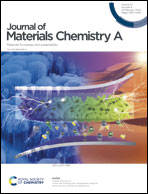High performance lithium ion electrolyte based on a three-dimensional holey graphene framework cross-linked with a polymer†
Abstract
Metallic lithium based batteries hold great promise for next generation high-performance lithium ion batteries mainly due to lithium with an extremely high theoretical capacity of 3860 mA h g−1 and a low redox potential of −3.04 V vs. Li+/Li. However, the uncontrollable growth of Li dendrites and severe safety issues caused by the use of conventional flammable liquid electrolytes largely limit their practical application. To address these critical issues, the development of solid state electrolytes with high ionic conductivity have been considered as an effective way. Herein, we report a polymer solid state electrolyte based on a three-dimensional holey graphene cross-linked with PEO composite (PE–hG) with LiNO3 addition. The PE–hG electrolyte exhibits a high ionic conductivity of 2.1 × 10−4 S cm−1 at 80 °C, a high Li+ transfer number of 0.87, large voltage stability over 4.65 V, vs. Li+/Li, and long-term cycling stability over 1200 h at a current density of 0.05 mA cm−2 with a controlled capacity of 0.05 mA h cm−2. The asymmetric LiFePO4‖PE–hG‖Li cell using the PE–hG as electrolyte demonstrates excellent lithium storage properties with a high initial reversible capacity of 135.8 mA h g−1 at 1C and an initial capacity retention of 71% over 350 cycles.



 Please wait while we load your content...
Please wait while we load your content...